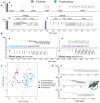Limited Song Mixing Without Genomic Gene Flow in a Contact Zone Between Two Songbird Species
- PMID: 36869752
- PMCID: PMC10050365
- DOI: 10.1093/molbev/msad053
Limited Song Mixing Without Genomic Gene Flow in a Contact Zone Between Two Songbird Species
Abstract
Song is considered to play an important role in the maintenance of prezygotic reproductive isolation between closely related songbird species. Therefore, song mixing in a contact zone between closely related species is often considered as evidence of hybridization. The Sichuan Leaf Warbler Phylloscopus forresti and the Gansu Leaf Warbler Phylloscopus kansuensis, which diverged 2 million years ago, have formed a contact zone in the south of the Gansu Province of China, where mixed songs have been observed. In this study, we investigated the potential causes and consequences of song mixing by integrating bioacoustic, morphological, mitochondrial, and genomic data with field ecological observations. We found that the two species display no apparent morphological differences, whereas their songs differ dramatically. We demonstrated that ∼11% of the males in the contact zone sang mixed songs. Two males singing mixed song were genotyped, and both were found to be P. kansuensis. Despite the presence of mixed singers, population genomic analyses detected no signs of recent gene flow between the two species, although two possible cases of mitochondrial introgression were identified. We conclude that the rather limited song mixing does not lead to, or result from, hybridization, and hence does not result in the breakdown of reproductive barriers between these cryptic species.
Keywords: contact zone; cryptic species; gene flow; hybridization; leaf warblers; song mixing.
© The Author(s) 2023. Published by Oxford University Press on behalf of Society for Molecular Biology and Evolution.
Conflict of interest statement
Conflict of interest statement. The authors declare no competing interests.
Figures




Similar articles
-
The causes and evolutionary consequences of mixed singing in two hybridizing songbird species (Luscinia spp.).PLoS One. 2013;8(4):e60172. doi: 10.1371/journal.pone.0060172. Epub 2013 Apr 5. PLoS One. 2013. PMID: 23577089 Free PMC article.
-
Sharp acoustic boundaries across an altitudinal avian hybrid zone despite asymmetric introgression.J Evol Biol. 2016 Jul;29(7):1356-67. doi: 10.1111/jeb.12876. Epub 2016 Apr 23. J Evol Biol. 2016. PMID: 27037611
-
Seasonality and social factors, but not noise pollution, influence the song characteristics of two leaf warbler species.PLoS One. 2021 Sep 2;16(9):e0257074. doi: 10.1371/journal.pone.0257074. eCollection 2021. PLoS One. 2021. PMID: 34473797 Free PMC article.
-
Where to from here? Perspectives on steroid-induced and naturally-occurring singing in female songbirds.Horm Behav. 2022 Feb;138:105098. doi: 10.1016/j.yhbeh.2021.105098. Epub 2021 Dec 10. Horm Behav. 2022. PMID: 34902757 Review.
-
The roles of time and ecology in the continental radiation of the Old World leaf warblers (Phylloscopus and Seicercus).Philos Trans R Soc Lond B Biol Sci. 2010 Jun 12;365(1547):1749-62. doi: 10.1098/rstb.2009.0269. Philos Trans R Soc Lond B Biol Sci. 2010. PMID: 20439279 Free PMC article. Review.
Cited by
-
Acoustic difference in advertisement calls among two sympatric Boulenophrys species: A confirmatory case to acoustic niche hypothesis and morphological constraint hypothesis.Ecol Evol. 2024 Apr 23;14(4):e11318. doi: 10.1002/ece3.11318. eCollection 2024 Apr. Ecol Evol. 2024. PMID: 38654713 Free PMC article.
-
Learning mimetic cuckoo call innovations from neighbors in a Chinese songbird.Sci Rep. 2024 Oct 15;14(1):24079. doi: 10.1038/s41598-024-74860-0. Sci Rep. 2024. PMID: 39402164 Free PMC article.
References
-
- Alatalo RV, Eriksson D, Gustafsson L, Lundberg A. 1990. Hybridization between pied and collared flycatchers - sexual selection and speciation theory. J Evol Biol. 3:375–389.
-
- Alcaide M, Scordato ESC, Price TD, Irwin DE. 2014. Genomic divergence in a ring species complex. Nature 511:83–U433. - PubMed
-
- Alström P, Olsson U. 1990. Taxonomy of the Phylloscopus proregulus complex. Bull Br Ornithol Club. 110:38–43.
-
- Alström P, Olsson U, Colston PR. 1997. Re-evaluation of the taxonomic status of Phylloscopus proregulus kansuensis Meise. Bull Br Ornithol Club. 117:53–57.
Publication types
MeSH terms
LinkOut - more resources
Full Text Sources

